 I’ve been getting at least one almost every single day for a while now. In the beginning they were annoying, but after the first few times I actually started to get a kick out of them. I even came to find them flattering. After all, the people who send them are generally well intentioned and often don’t realize they are being rude. Some of them are actually very polite. I’m talking, of course, about emails like this one:
I’ve been getting at least one almost every single day for a while now. In the beginning they were annoying, but after the first few times I actually started to get a kick out of them. I even came to find them flattering. After all, the people who send them are generally well intentioned and often don’t realize they are being rude. Some of them are actually very polite. I’m talking, of course, about emails like this one:
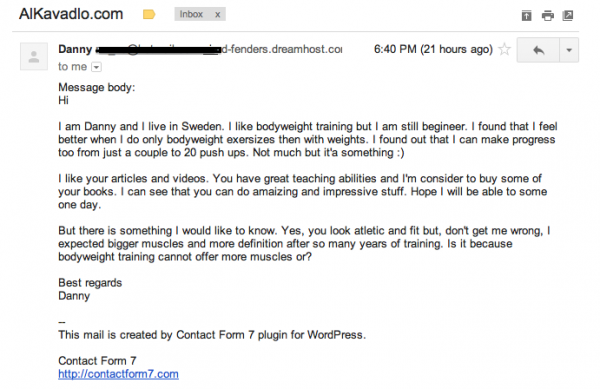 If I had seen the me of today when I was a teen, I probably would have wondered the same thing. After all, the main reason I got into strength training was because I was a scrawny kid who wanted to build some muscle. Fourteen-year-old Al would be very disappointed that after 20+ years of working out I still wasn’t as massive as the Incredible Hulk.
If I had seen the me of today when I was a teen, I probably would have wondered the same thing. After all, the main reason I got into strength training was because I was a scrawny kid who wanted to build some muscle. Fourteen-year-old Al would be very disappointed that after 20+ years of working out I still wasn’t as massive as the Incredible Hulk.
In fact, even though I’m about 30 pounds heavier now than I was at age fourteen (in spite of not growing an inch taller since then), I’m still a fairly small guy. And though my bodyfat percentage sits comfortably in the 8-12% range (I tend to naturally lean out in the summer), at a height of 5’11’’, I’m incredibly small by bodybuilding standards. Good thing I’m not interested in becoming a bodybuilder!
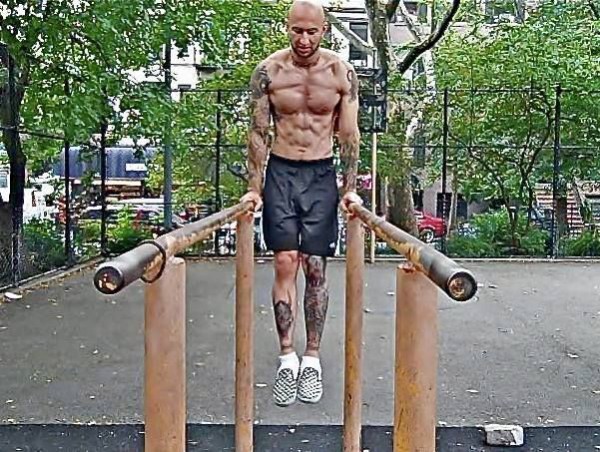 As a kid, however, I desperately wanted to bulk up. Though I managed to beef up to 190 pounds by my early twenties, I eventually came to find that I felt and performed better when I wasn’t carrying so much mass. Though bulky muscle-men seemed ubiquitous to me in my youth, as an adult I soon discovered that to people who weren’t fans of pro wrestling and Arnold movies (which, shockingly, is most people), being overly bulky is a turn-off. It took me a long time to change my perspective, but I’ve since learned to embrace my physique and take advantage of its benefits.
As a kid, however, I desperately wanted to bulk up. Though I managed to beef up to 190 pounds by my early twenties, I eventually came to find that I felt and performed better when I wasn’t carrying so much mass. Though bulky muscle-men seemed ubiquitous to me in my youth, as an adult I soon discovered that to people who weren’t fans of pro wrestling and Arnold movies (which, shockingly, is most people), being overly bulky is a turn-off. It took me a long time to change my perspective, but I’ve since learned to embrace my physique and take advantage of its benefits.
Though there are a few notable exceptions, most advanced bodyweight practitioners tend not to have huge, imposing physiques. Instead, high level calisthenics athletes usually have more of a lean, athletic build. After all, if pound-for-pound strength is the goal, it helps to be relatively light. The higher your muscle to weight ratio, the better off you’re going to be in regard to bodyweight training. Though you definitely need some muscle mass to achieve high levels of strength, it’s more pragmatic to make a little muscle go a long way. At a certain point having too much mass becomes cumbersome. It’s weighs you down more than it helps.
Build Your Foundation
Regardless of whether your aim is to add muscle mass or simply get strong, the first thing you need to do when you begin training calisthenics is build a solid foundation. Though everyone starts at a different place, building to at least 40 bodyweight squats, 30 push-ups, 20 hanging knee raises and 10 pull-ups (those numbers might look familiar) is a prerequisite that should be achievable within a few months (or a few years, depending on where you’re starting).
Women should aim for the same numbers, but with knee push-ups and Australian pull-ups in place of the full ones. This is not an issue of sexism. Biologically, women have a lower propensity for upper-body strength as compared to men. Of course with proper training, women have the potential to develop serious upper-body strength!
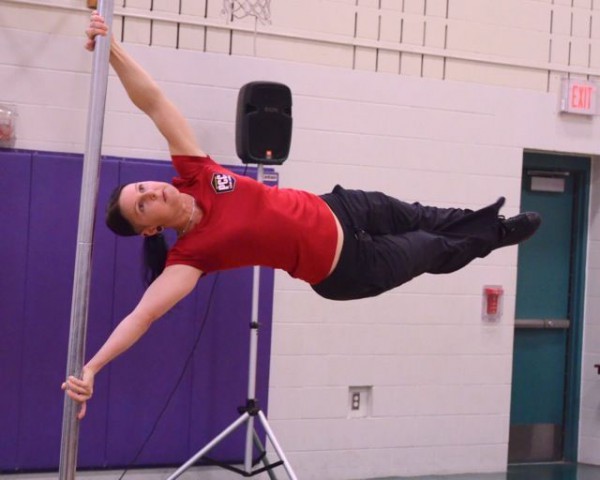 Once you’ve established that baseline of fitness, you’ll have likely built a bit of strength, stamina and muscle along the way. If you aren’t looking to grow your muscles past this point, however, it’s time to start training more advanced exercises and leave the high reps to your warm-ups.
Once you’ve established that baseline of fitness, you’ll have likely built a bit of strength, stamina and muscle along the way. If you aren’t looking to grow your muscles past this point, however, it’s time to start training more advanced exercises and leave the high reps to your warm-ups.
Skill Out
It is often said that strength is a skill, and like any skill, the way that you get better is consistent practice. The goal of a strength workout is not to focus on the quantity of reps, but instead the quality. I recommend sticking with sets of 3-5 reps. However, it is helpful to add additional sets to offset the low rep range and allow for adequate volume. For this reason, I suggest performing 3-5 sets of each movement in a given workout when strength is the primary goal. Remember, you don’t need to do the same amount of volume as you would in a hypertrophy workout. The most you’ll probably ever need to do of a single exercise is 25 reps per workout. We’re not necessarily looking to get a pump, either. In fact, you’ll want to take longer breaks in between sets when you’re doing pure strength work than when the goal is mass-building. I recommend anywhere between 2-5 minutes of rest between sets.
It’s important to understand that strength is as much neurological as it is physical. Whenever you try to get your body to do something that it isn’t used to doing, it has to build a new neurological pathway to make it happen. Even when you ask your body to perform a familiar movement pattern, it will have a hard time if the leverage has been made less favorable than what it’s become accustomed to. Your brain has never had to send that specific message to your muscle before, so it must work very hard in order to arrive there. The message often comes in fuzzy.
Imagine using a machete to chop your way through the thick vines of a jungle. This is how hard your brain must work to get your body to do something for the first time. Now imagine you’ve lived in that jungle for ten years and walked the same few routes over and over, gradually clearing away the brush little by little. Eventually the path would be easy to walk and you’d arrive on the other side much more quickly, and with much less effort.
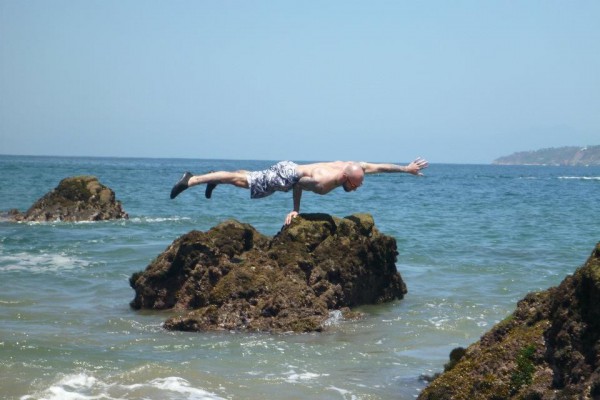 The same thing happens in your brain with consistent training. Over time, the pathway becomes clearer and the message arrives faster. The body adapts to whatever stimuli it is consistently exposed to. A body that is regularly called upon to apply force against resistance will get better at doing so.
The same thing happens in your brain with consistent training. Over time, the pathway becomes clearer and the message arrives faster. The body adapts to whatever stimuli it is consistently exposed to. A body that is regularly called upon to apply force against resistance will get better at doing so.
Lean Machine
Diet may be the single biggest factor that determines whether or not you will increase or decrease in size. If you want to grow, you’ve got to eat a lot. Conversely, if you’re not interested in gaining weight, you shouldn’t be overeating. Though nutrition is a bit more complex than a simple calories-in minus calories-out equation, nobody ever gained significant bulk without the calories to back it up. Conversely, you can’t lose fat without being in a caloric deficit.
Personally, I follow a very simple diet: I eat when I am hungry and stop when I am full. I avoid mindless snacking and stay away from processed foods. I’m not trying to gain mass, but I’m not trying to lose it either. People love to ask me how many grams of protein I consume each day or how I time my carbohydrate intake, but the truth is I don’t concern myself with such trivialities. There is no need for the average person to possess a profound knowledge of nutrition in order to have a lean, strong physique. One need not understand how free radicals and antioxidants work in order to know that eating blueberries is healthy.
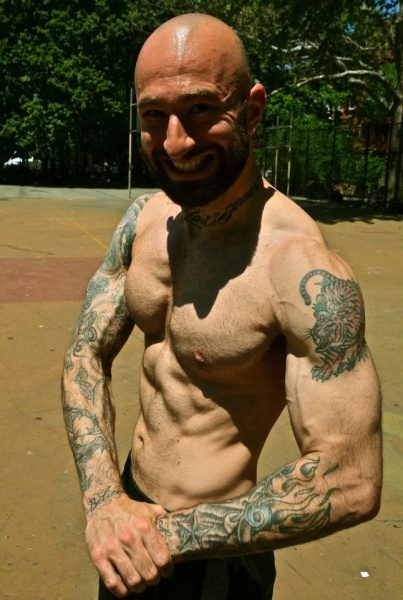 Regardless of your ambitions, the most important thing is being consistent with your training. Focus on making regular exercise a part of your lifestyle. Don’t over-analyze the details, especially if you aren’t doing the work physically. Of course if nutritional science is of genuine interest to you, there’s no reason to ignore that yearning.
Regardless of your ambitions, the most important thing is being consistent with your training. Focus on making regular exercise a part of your lifestyle. Don’t over-analyze the details, especially if you aren’t doing the work physically. Of course if nutritional science is of genuine interest to you, there’s no reason to ignore that yearning.
Just don’t make your life any more complicated than it has to be. When all is said and done, the most important thing is to respect and appreciate the body you have. It’s great to strive for physical perfection, but the journey matters more than the destination.
***
About Al Kavadlo: Al Kavadlo is the lead instructor for Dragon Door’s Progressive Calisthenics Certification. Recognized worldwide for his amazing bodyweight feats of strength as well as his unique coaching style, Al is the author of three books, including Raising The Bar: The Definitive Guide to Pull-up Bar Calisthenics and Pushing The Limits! Total Body Strength With No Equipment. Read lots more about Al on his website:www.AlKavadlo.com.